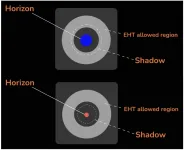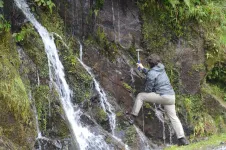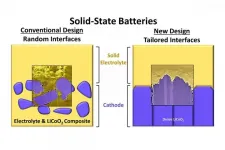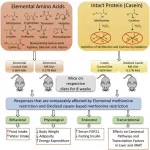Not all theories can explain the black hole M87*
Scientists at Goethe University Frankfurt and the Event Horizon Telescope Collaboration use data which produced the first image of a black hole to constrain its fundamental properties
2021-05-20
(Press-News.org) FRANKFURT. As first pointed out by the German astronomer Karl Schwarzschild, black holes bend space-time to an extreme degree due to their extraordinary concentration of mass, and heat up the matter in their vicinity so that it begins to glow. New Zealand physicist Roy Kerr showed rotation can change the black hole's size and the geometry of its surroundings. The "edge" of a black hole is known as the event horizon, the boundary around the concentration of mass beyond which light and matter cannot escape and which makes the black hole "black". Black holes, theory predicts, can be described by a handful of properties: mass, spin, and a variety of possible charges.
In addition to black holes predicted from Einstein's theory of general relativity, one can consider those from models inspired by string theories, which describe matter and all particles as modes of tiny vibrating strings. String-inspired theories of black holes predict the existence of an additional field in the description of fundamental physics, which leads to observable modifications in the sizes of black holes as well as in the curvature in their vicinity.
Physicists Dr Prashant Kocherlakota and Professor Luciano Rezzolla from the Institute for Theoretical Physics at Goethe University Frankfurt, have now investigated for the first time how the different theories fit with the observational data of the black hole M87* at the centre of the galaxy Messier 87. The image of M87*, taken in 2019 by the international Event Horizon Telescope (EHT) collaboration, was the first experimental proof of the actual existence of black holes after the measurement of gravitational waves in 2015.
The result of these investigations: The data from M87* are in excellent agreement with the Einstein-based theories and to a certain extent with the string-based theories. Dr Prashant Kocherlakota explains: "With the data recorded by the EHT collaboration, we can now test different theories of physics with black hole images. Currently, we cannot reject these theories when describing the shadow size of M87*, but our calculations constrain the range of validity of these black hole models."
Professor Luciano Rezzolla says: "The idea of black holes for us theoretical physicists is at the same time a source of concern and of inspiration. While we still struggle with some of the consequences of black holes - such as the event horizon or the singularity - we seem always keen to find new black hole solutions also in other theories. It is therefore very important to obtain results like ours, which determine what is plausible and what is not. This was an important first step and our constraints will be improved as new observations are made".
In the Event Horizon Telescope collaboration, telescopes from around the globe are interconnected to form a virtual giant telescope with a dish as big as the Earth itself. With the precision of this telescope, a newspaper in New York could be read from a street café in Berlin.
INFORMATION:
Video: Testing different theories of gravity with the data obtained
https://youtu.be/Xf8He6Z1eQU
The EHT collaboration involves more than 300 researchers from Africa, Asia, Europe, North and South America. The international collaboration is working to capture the most detailed black hole images ever obtained by creating a virtual Earth-sized telescope. Supported by considerable international investment, the EHT links existing telescopes using novel systems -- creating a fundamentally new instrument with the highest angular resolving power that has yet been achieved.
The individual telescopes involved are: ALMA, APEX, the IRAM 30-meter Telescope, the IRAM NOEMA Observatory, the James Clerk Maxwell Telescope (JCMT), the Large Millimeter Telescope (LMT), the Submillimeter Array (SMA), the Submillimeter Telescope (SMT), the South Pole Telescope (SPT), the Kitt Peak Telescope, and the Greenland Telescope (GLT).
The EHT consortium consists of 13 stakeholder institutes: The Academia Sinica Institute of Astronomy and Astrophysics, the University of Arizona, the University of Chicago, the East Asian Observatory, Goethe-Universitaet Frankfurt, Institut de Radioastronomie Millimétrique, Large Millimeter Telescope, Max Planck Institute for Radio Astronomy, MIT Haystack Observatory, National Astronomical Observatory of Japan, Perimeter Institute for Theoretical Physics, Radboud University and the Smithsonian Astrophysical Observatory.
Goethe University is a research-oriented university in the European financial centre Frankfurt am Main. The university was founded in 1914 through private funding, primarily from Jewish sponsors, and has since produced pioneering achievements in the areas of social sciences, sociology and economics, medicine, quantum physics, brain research, and labour law. It gained a unique level of autonomy on 1 January 2008 by returning to its historic roots as a "foundation university". Today, it is one of the three largest universities in Germany. Together with the Technical University of Darmstadt and the University of Mainz, it is a partner in the inter-state strategic Rhine-Main University Alliance. Internet: http://www.uni-frankfurt.de
[Attachments] See images for this press release:

ELSE PRESS RELEASES FROM THIS DATE:
2021-05-20
When scientists hunt for life, they often look for biosignatures, chemicals or phenomena that indicate the existence of present or past life. Yet it isn't necessarily the case that the signs of life on Earth are signs of life in other planetary environments. How do we find life in systems that do not resemble ours?
In groundbreaking new work, a team* led by Santa Fe Institute Professor Chris Kempes has developed a new ecological biosignature that could help scientists detect life in vastly different environments. Their work appears as part of a special issue of theBulletin ...
2021-05-20
The chemical bisphenol F (found in plastics) can induce changes in a gene that is vital for neurological development. This discovery was made by researchers at the universities of Uppsala and Karlstad, Sweden. The mechanism could explain why exposure to this chemical during the fetal stage may be connected with a lower IQ at seven years of age - an association previously seen by the same research group. The study is published in the scientific journal Environment International.
"We've previously shown that bisphenol F (BPF for short) may be connected with children's cognitive development. However, with this study, we can now begin to understand which biological mechanisms may explain such a link, which is unique for an epidemiological study." ...
2021-05-20
A new study provides public health planning authorities with a method of calculating the number of COVID-19 isolation beds they would need for people experiencing homelessness based on level of infection in the city. The research holds promise for controlling spread of the virus - or future infectious diseases - in a population that is highly vulnerable and less likely than many others to access health care services.
The report, developed to support public health decision-making in Austin, Texas, was recently published by PLOS ONE. The paper's first author is an undergraduate student at The University of Texas at Austin, Tanvi Ingle, who harnessed ...
2021-05-20
In April 2017, a landslide in Mocoa, Colombia, ripped through a local town, killing more than 300 people. Nicolás Pérez-Consuegra grew up about 570 miles north in Santander, Colombia, and was shocked as he watched the devastation on television. At that time, he was an undergraduate intern at the Smithsonian Tropical Research Institute in Panama. As a budding geologist raised hiking the tropical mountains of Colombia, he wondered, what causes greater erosion in some areas of the mountains than in others? And, is it tectonic forces - where Earth's tectonic plates slide against one another leading to the formation of steep mountains - or high precipitation rates, that play a more important role in causing erosion within that region?
To answer those questions would require a geological ...
2021-05-20
Scientists have discovered that the way in which neurons are connected within regions of the brain, can be a better indicator of disease progression and treatment outcomes for people with brain disorders such as epilepsy.
Many brain diseases lead to cell death and the removal of connections within the brain. In a new study, published in Human Brain Mapping, a group of scientists, led by Dr Marcus Kaiser from the School of Medicine at the University of Nottingham, looked at epilepsy patients undergoing surgery.
They found that changes in the local network within brain regions can be a better predictor ...
2021-05-20
More than 90 years ago, astronomer Edwin Hubble observed the first hint of the rate at which the universe expands, called the Hubble constant.
Almost immediately, astronomers began arguing about the actual value of this constant, and over time, realized that there was a discrepancy in this number between early universe observations and late universe observations.
Early in the universe's existence, light moved through plasma--there were no stars yet--and from oscillations similar to sound waves created by this, scientists deduced that the Hubble constant was about 67. This means the universe expands about 67 kilometers per second faster every 3.26 million light-years.
But this observation differs when scientists look at the universe's ...
2021-05-20
BOSTON - Dana-Farber Cancer Institute researchers are presenting dozens of research studies at the 2021 Annual Meeting of the American Society of Clinical Oncology (ASCO). The studies will be presented during the virtual program on June 4-8, 2021. ASCO is the world's largest clinical cancer research meeting, attracting more than 30,000 oncology professionals from around the world.
Toni K. Choueiri, MD, the director of the Lank Center for Genitourinary Oncology at Dana-Farber, will present results from the randomized, double-blind, phase III KEYNOTE-564 trial evaluating pembrolizumab versus placebo after surgery in patients with renal cell carcinoma (abstract LBA5) during ASCO's Plenary Session on Sunday, June ...
2021-05-20
CHAMPAIGN, Ill. -- Solid-state batteries pack a lot of energy into a small space, but their electrodes are not good at keeping in touch with their electrolytes. Liquid electrolytes reach every nook and cranny of an electrode to spark energy, but liquids take up space without storing energy and fail over time. Researchers are now putting solid electrolytes in touch with electrodes made of strategically arranged materials - at the atomic level - and the results are helping drive better solid-state battery technologies.
A new study, led by University of Illinois Urbana-Champaign materials science and engineering professor Paul Braun, postdoctoral research associate Beniamin Zahiri, and Xerion Advanced Battery Corp. director of research and development ...
2021-05-20
The University of Maryland (UMD) co-published a new review paper in the Annual Review of Resource Economics to examine pollinators from both an economic and ecological perspective, providing much needed insight into the complexities of valuing pollination. Pollinators are not only a critical component of a healthy ecosystem, but they are also necessary to produce certain foods and boost crop yields. While native and wild pollinators (whether they be certain bee species, other insects and animals, or just the wind) still play an important role, managed honey bee colonies are commercially trucked around the U.S. to meet the need for pollination services in agricultural products. Recent reports of ...
2021-05-20
BATON ROUGE, Louisiana - A diet that improves the biomarkers of metabolic health, and that could potentially slow the aging process, has moved a step closer to reality.
"We've known for years that restricting the amino acid methionine in the diet produces immediate and lasting improvements in nearly every biomarker of metabolic health," said Thomas W. Gettys, PhD, Professor and Director, Nutrient Sensing and Adipocyte Signaling Laboratory at Pennington Biomedical Research Center. "The problem is that methionine-restricted diets have been difficult to implement because they taste so bad."
Until now. Restricting methionine normally involves diets formulated with elemental (e.g., individual) amino acids. Individual amino acids are the building blocks ...
LAST 30 PRESS RELEASES:
[Press-News.org] Not all theories can explain the black hole M87*
Scientists at Goethe University Frankfurt and the Event Horizon Telescope Collaboration use data which produced the first image of a black hole to constrain its fundamental properties





